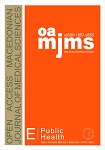The Identification of Modeling Causes of Stunting Children Aged 2–5 Years in Aceh Province, Indonesia (Data Analysis of Nutritional Status Monitoring 2015)
DOI:
https://doi.org/10.3889/oamjms.2020.4659Keywords:
Child 2–5 years, Parenting, Economic and social, StuntingAbstract
BACKGROUND: The prevalence of stunting problems in toddlers in 2015 in Aceh Province has proven to be very high due to various factors ranging from a mother’s educational background to socioeconomic family.
AIM: The purpose of this study was to identify models of factors that cause stunting in children aged 2–5 years in Aceh Province.
METHODS: To be able to identify the problem above, this quantitative research was reported in a descriptive analytic form with a cross-sectional design that was successfully conducted from April to December 2019. The data collected were a combination of field observation review and documentation. To facilitate data analysis, univariate and bivariate and multivariate have been applied to see the validation and reliability of this research question.
RESULTS: The results showed that the incidence of stunting in children included the level of education and knowledge of the mother, head of the family, number of family members, initiation of early breastfeeding, exclusive breastfeeding, age of weaning, supplementary feeding, and provision of Vitamin A (p < 0.05). The dominant factors affecting stunting were 16.7 times exclusive breastfeeding, 10.6 times because they were not given complementary feeding, 3.5 times because they did not get Vitamin A capsules, 1.7 times due to poor weaning age, and 1.5 times because the head of the family does not have a good income. Several variables did not affect the incidence of stunting, such as education of the head of the family (p = 0.482) and mother’s occupation (p = 0.992).
CONCLUSION: Stunting is caused by direct and indirect factors. Models in dealing with stunting can be done by maximizing better breastfeeding.
Downloads
Metrics
Plum Analytics Artifact Widget Block
References
United Nation Development Programme. Human Development Report 2011. Sustainability and Equity: A Better Future for All. New York: United Nation Development Programme; 2011. https://doi.org/10.18356/fdcff8d6-en
Badan Pusat Statistik. Ketimpangan Pendidikan di Indonesia. Pemerataan Akses Pelayanan Kesehatan Menuju Indonesia Sehat. Indikator Kesejahteraan Rakyat. Jakarta: Badan Pusat Statistik; 2016. https://doi.org/10.33007/inf.v2i1.190
Badan Pusat Statistik. Pemerataan Akses Pelayanan Kesehatan Menuju Indonesia Sehat. Indikator Kesejahteraan Rakyat. Jakarta: Badan Pusat Statistik; 2017.
United Nation Children’s Fund. The State of the World’s Children 2014 in Number: Every Child Counts. New York: United Nations Children’s Fund; 2014. https://doi.org/10.18356/8504d62b-en
World Health Organization. Global Nutrition Targets 2025: Stunting Policy Brief. Geneva: World Health Organization; 2014.
World Health Organization. Training Course on Child Growth Assessment: Interpreting Growth Indicators. Geneva: World Health Organization; 2008.
Kudlová E, Schneidrová D. Dietary patterns and their changes in early childhood. Cent Eur J Public Health. 2012;20(2):126-34. https://doi.org/10.21101/cejph.a3703 PMid:22966737
Atmarita. Nutrition problem in Indonesia. An Integrated International Seminar and Workshop on Lifestyle. Yogyakarta: Gadja Mada University; 2005.
Victora CG, De Onis M, Hallal PC, Blössner M, Shrimpton R. Worldwide timing of growth faltering: Revisiting implications for interventions. Pediatrics. 2010;125(3):e473-80. https://doi.org/10.1542/peds.2009-1519 PMid:20156903
Ulfani DH, Martianto D, Baliwati YF. Faktor-faktor sosial ekonomi dam kesehatan masyarakat kaitannya dengan masalah gizi underweight, stunted, dan wasted di Indonesia: Pendekatan ekologi gizi. J Gizi Pangan. 2011;6(1):59-65. https://doi.org/10.25182/jgp.2011.6.1.59-65
Aditianti F. Faktor determinan stunting pada anak usia 24-59 bulan di Indonesia. J Info Pangan Gizi. 2010;19:2. https://doi.org/10.32382/mgp.v25i1.64
Fentaw R, Bogale A, Abebaw D. Prevalence of child malnutrition in agro-pastoral households in Afar Regional State of Ethiopia. Nutr Res Pract. 2013;7(2):122-31. https://doi.org/10.4162/nrp.2013.7.2.122 PMid:23610605
Senbanjo IO, Oshikoya KA, Odusanya OO, Njokanma OF. Prevalence of and risk factors for stunting among school children and adolescents in Abeokuta, Southwest Nigeria. J Health Popul Nutr. 2011;29(4):364-70. https://doi.org/10.3329/jhpn.v29i4.8452 PMid:21957675
Maleta K. Undernutrition. Malawi Med J. 2006;18(4):189-205. PMid: 27529011
Amare B, Moges B, Fantahun B, Tafess K, Woldeyohannes D, Yismaw G, et al. Micronutrient levels and nutritional status of school children living in Northwest Ethiopia. Nutr J. 2012;11:108. https://doi.org/10.1186/1475-2891-11-108 PMid:23237638
Walker SP, Chang SM, Powell CA, Simonoff E, Grantham- McGregor SM. Early childhood stunting is associated with poor psychological functioning in late adolescence and effects are reduced by psychosocial stimulation. J Nutr. 2007;137(11):2464- 9. https://doi.org/10.1093/jn/137.11.2464 PMid:17951486
De Onis M, Blössner M. The World Health Organization global database on child growth and malnutrition: Methodology and applications. Int J Epidemiol. 2011;32:518-26. https://doi.org/10.1093/ije/dyg099
Brito GN, De Onis M. Growth status and academic performance in Brazilian school age children: Growth retardation impairs mathematical, but not reading and spelling abilities. Arq Neuropsiquiatr. 2006;64(4):921-5. https://doi.org/10.1590/s0004-282x2006000600006
Daniels MC, Adair LS. Growth in young Filipino children predicts schooling trajectories through high school. J Nutr. 2004;134(6):1439-46. https://doi.org/10.1093/jn/134.6.1439 PMid:15173409
World Bank. Improving Nutrition Through Multisectoral Approaches. New York: World Bank; 2013.
Downloads
Published
How to Cite
Issue
Section
Categories
License
Copyright (c) 2020 Bustami Bustami, Miko Ampera (Author)

This work is licensed under a Creative Commons Attribution-NonCommercial 4.0 International License.
http://creativecommons.org/licenses/by-nc/4.0







